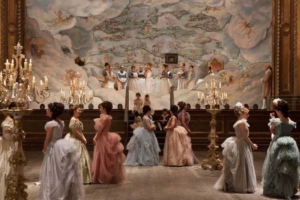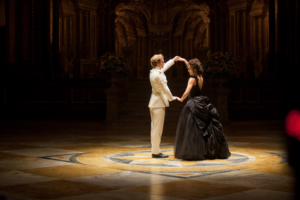 Joe Wright, master of dreamy-gorgeous emotional wonderscapes, has released a rendition of Anna Karenina filmed primarily in a derelict Russian theater. The script is literal, condensing the magnum opus into just over two-hours, but the staging is experimental. The set shifts around the actors, with backdrops changing from scene to scene. As it opens, a character moves through a rhythmic factory scene (a more gentle version of Modern Times), through the inner-workings of the theater (a metaphor for a bustling city) and into the stage set of his home, an economic way to show that his domestic life is a bit of a sham. Throughout the film, Wright guides us through these sometimes-lengthy scenes of coordinated and choreographed ensemble sequences, never veering towards musical camp. It is ballet with words, a peculiar and lovely staging that breaks the rules of the period drama.
Joe Wright, master of dreamy-gorgeous emotional wonderscapes, has released a rendition of Anna Karenina filmed primarily in a derelict Russian theater. The script is literal, condensing the magnum opus into just over two-hours, but the staging is experimental. The set shifts around the actors, with backdrops changing from scene to scene. As it opens, a character moves through a rhythmic factory scene (a more gentle version of Modern Times), through the inner-workings of the theater (a metaphor for a bustling city) and into the stage set of his home, an economic way to show that his domestic life is a bit of a sham. Throughout the film, Wright guides us through these sometimes-lengthy scenes of coordinated and choreographed ensemble sequences, never veering towards musical camp. It is ballet with words, a peculiar and lovely staging that breaks the rules of the period drama.
The staging is emotional and melodramatic. The puppet-theater metaphor is an easy grasp; society has not only forced the elite 19th century Russians into a performative world, but it has also trapped them in a crumbling cage. Both Wright and production designer Sarah Greenwood, have referenced Orlando Figes’ Natasha’s Dance: A Cultural History of Russia, which hypothesizes that elite Russians lived as if they were actors on a stage. Wright delights in showing the characters perform: over-emphasized bowing, teacup holding, fan flitting. The stage also efficiently communicates the upstairs-downstairs divide as servants and workers wait in the wings, down in the bowels of the theater or perched precariously in the attic. Above all though, it is the cage-like metaphor that comes across most clearly in the theater scenes.
The most evocative moment in the film is the ballroom scene; in my opinion, it’s the most gorgeous romantic sequence in any film this year (save for the whirling carnival scene of Take this Waltz, which actually bears several outstanding similarities). As Anna and Vronsky dance, they fall in love. As they spin and move their arms like long bird necks engaged in a mating ritual, the circular auditorium becomes a revolving whirl of emotion. As the camera surrounds them, it also flashes back to another young woman, Kitty, who was previously about to be engaged to Vronsky. As an audience, we simultaneously see a couple completely absorbed in each other’s being, a whirling crowd casting judgment, and a young woman’s heart breaking. We see a coming together, then a ripping apart.
 The times when Wright breaks outside the stage set and into the ‘wilds’ for some lush outdoors scenes are given more meaning because of their contrast to the stage sets. Usually these scenes involve a closer connection to nature – the characters are usually harvesting or loving. This is where we usually see Levin, the character that most resists the confines of Russian high society. (As an aside, Tolstoy-devotees, myself included, were thrilled to see this character given so much screen time, as he is often left out of film adaptations.) Because of the claustrophobic stage set earlier, the audience can immediately understand that in these scenes, the characters are finally able to act naturally.
The times when Wright breaks outside the stage set and into the ‘wilds’ for some lush outdoors scenes are given more meaning because of their contrast to the stage sets. Usually these scenes involve a closer connection to nature – the characters are usually harvesting or loving. This is where we usually see Levin, the character that most resists the confines of Russian high society. (As an aside, Tolstoy-devotees, myself included, were thrilled to see this character given so much screen time, as he is often left out of film adaptations.) Because of the claustrophobic stage set earlier, the audience can immediately understand that in these scenes, the characters are finally able to act naturally.
Other films have played with the stage set as a metaphor, but less abstractly than Wright’s Anna. Usually, there is a play-within-a-play or the “theater” is part of its plot. The metaphor is usually a little on-the-nose; the contrasts between societal pressure and unencumbered action are divided between onstage and offstage. For example, in Hitchcock’s Stage Fright 1950 with Jane Wyman, Marlene Dietrich, backstage was a representation of danger, murder, ill thought. In true Hitchcockian fashion, the space represented the dark wiles of the human condition. Tom Stoppard, who penned this Anna Karenina screenplay, aimed for a similar dichotomy with 1998’s Shakespeare in Love — though more romantic, less threatening than Stage Fright.
Wright also uses costumes to a similar effect as the stage. Often, period costume can give the characters a sort of mythology; it’s clear they are part of a time removed from ours. Wright’s movie undoes this by making it clear that they’re playing dress up. Jacqueline Durran’s costume design — 50s couture with 1870s silhouettes — gives the costumes a simultaneously timeless and dated look. Unlike Baz Luhrmann’s jukebox musical Moulin Rouge, which also played with notions of time period, Luhrmann’s Bollywood-inspired efforts aimed to be a spectacle, unlike the almost understated Karenina.
Two other films, similar to Wright’s Anna, that use the stage purely as metaphor come from Danish director Lars Von Trier. 2005’s Manderlay and his 2003 film Dogville, a film that is so different from Karenina in tone, but perhaps draws some parallels as the central character is a tortured woman who attempts to escape some internal struggles. The film employs an extremely minimal stage-like set, something similar to a black box theater. Another Brechtian attempt to employ theater is Charlie Kaufman’s Synecdoche, New York, while it involves theater, it uses the stage in a similarly metaphorical way. Unlike Dogville or Synecdoche, the staging and theatrical set doesn’t function with a distancing effect in Anna Karenina, but instead draw the viewer in, as a live performance might. The actors are obviously performing, but their performance is a metaphor. It’s melodrama, not meta.
This is new and risky, but Wright carries it off in a way that is so beautiful and practiced and sensible, that it doesn’t seem as if the director is testing something new out on us. It’s a gorgeous and transportive film, that uses its innovative set, staging, and costumes to access the essence of Tolstoy’s original material.
You can find Maggie Lange at maggielangewrites.com or follow her on Twitter @maggielange.
This post may contain affiliate links.








